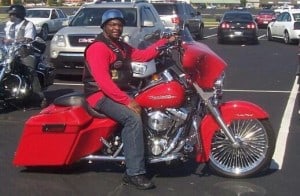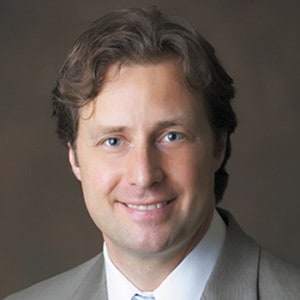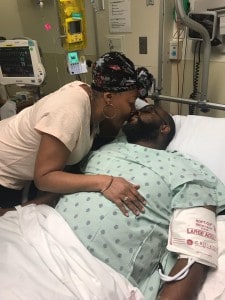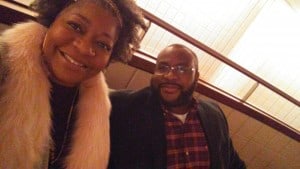After five kids and 11 grandkids, Kevin and Yolanda Newman are used to working as a team.
When a New Year’s Eve motorcycle accident left Kevin with life-threatening injuries, he needed Yolanda’s love and support more than ever – and that, along with the care he received at Regional One Health, has him on the road to recovery.

Kevin Newman sits atop the 2004 Harley Davidson Road King motorcycle he was driving when a car crossed five lines of traffic and pulled in front of him.
Kevin was driving his Harley Davidson Road King motorcycle near his Dyersburg home when a car pulled directly in front of him. He barely had time to register what happened, much less stop. “Upon impact, everything shifted forward, and I hit my pelvis and ribcage on the forward parts of the motorcycle,” Kevin said. “That sent me over the car, and I hit the ground.”
His helmet saved his life, but he suffered devastating injuries: an ‘open-book’ pelvic fracture, seven broken ribs, and countless bruises and abrasions. He was unconscious when paramedics airlifted him to Regional One Health’s Elvis Presley Trauma Center.
“I do have one memory, of them telling me to remain calm. They had to basically tie me together around the waist because they were afraid I’d bleed out,” he said. “My pelvis was broken so badly it was pretty much mush.”
At the trauma center, surgeon Matthew Rudloff, MD used fluoroscopy and a minimally-invasive technique to place screws in Kevin’s pelvis.

Jerry Jones, MD has pioneered a technique to relieve patients’ pain without opioids. In Kevin’s case, it helped him recover more quickly and almost eliminate dangerous narcotics.
Jerry Jones, MD, Division Chief of Regional Anesthesia and Acute Pain Medicine and Director of the Acute Pain Service, came in with hopes of alleviating Kevin’s severe pelvic injury pain. Dr. Jones had already been consulted to treat Kevin’s ribcage pain so he could take deep breaths and cough – keys to preventing pneumonia – but that was not Kevin’s greatest source of pain.
The pain is one of the few things Kevin remembers from his first few days in the hospital, and Yolanda struggled watching her husband suffer – until Dr. Jones was able to change the game. “To have my husband alive was such a blessing, but to see him go from screaming in pain to smiling and making us laugh was just as incredible,” Yolanda said.
At Regional One Health, Dr. Jones spearheads the use of Continuous Peripheral Nerve Blocks to manage pain so patients can participate in their own recovery and avoid using opioids. While Dr. Jones is a pioneer in the treatment, Kevin’s case was unlike any he’d encountered.
His first step was ascertaining Kevin’s worst pain wasn’t his ribs, but his lower back.
“He listened to me. He came in with an idea of what needed to be done, but told me he needed to hear specific things from me to narrow down my treatment,” Kevin said.
Dr. Jones had never used a nerve block for this kind of pelvic fracture before, but as is often the case, out of necessity came innovation. With Dr. Rudloff literally using a model skeleton to demonstrate the operation he was about to do, Dr. Jones determined he could apply nerve blocks, which use a tiny catheter to supply local anesthetic medication from a pump, on both sides of Kevin’s sacrum.

Yolanda was Kevin’s rock throughout his ordeal, and she in turn felt supported by the doctors and nurses caring for her husband.
It worked, sparking a memorable moment: “He asked me what I’d done and I told him I didn’t have a name for it yet, it was so new,” Dr. Jones said. “He said, ‘I call it Flashdance. I feel so good I could get up and dance.’ Those were the first words he’d said to me.”
Looking back, Kevin adds another word: “Lifesaver. He was a lifesaver in terms of pain.”
Indeed, nerve blocks, which numb nerves that control pain in the affected area, get patients past the acute pain period. In Kevin’s case, he basically eliminated opioids, which is good for several reasons, Dr. Jones said.
Patients recover faster because they are alert enough to participate in therapies, rather than lying in bed, risking blood clots, pulmonary complications, etc. In turn, they go home sooner – a positive in terms of patient well-being and saving the health system money.
Finally, Dr. Jones said, heavy painkiller use risks addiction: “It can happen easily, because you’re flooding them with narcotics. You don’t even need giant doses – studies show a small prescription for a week increases chances of abusing painkillers. So why don’t we just avoid it?”
He hopes Kevin’s case will lead to more successes. Dr. Jones noted the procedure Dr. Rudloff performed on Kevin is common in trauma, so the new nerve block can have frequent application at Regional One Health. Ultimately, he hopes to adapt the technique for “the regular guy in the regular hospital undergoing a routine surgery.”

Kevin and Yolanda are grateful for the care he received at Regional One Health. “We ended up at the right place at the right time – there’s no doubt about it,” Kevin said.
To do so, the ingrained idea of pumping patients full of opioids must change, a message Dr. Jones wants doctors and patients to heed: “It’s not reality that you simply have to take narcotics. There are other options; better options.”
For Kevin, those better options changed the game, and he’s grateful to Regional One Health. “I never felt like I was just a number or a body. They were always attentive to everything I needed. We ended up at the right place at the right time – there’s no doubt about it.”
He’s also grateful to someone else – his wife. “There were many nights I was in pain and just wanted to give up, but she kept my spirits up and hid her own worries,” Kevin said. “She was able to be my support system because everyone made her feel comfortable and supported. They allowed her to make me feel comfortable.”
Now, Kevin is back home, looking forward to getting back to his favorite hobbies.
“I love working out in the yard,” he said. “This happened before I got all the Christmas stuff off the house, and we’ve had lots of people stopping by to help – but there’s nothing like doing it yourself. I don’t feel too bad about the lights still being up, though!”

